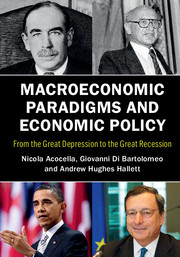Book contents
- Frontmatter
- Dedication
- Contents
- List of figures
- List of tables
- Preface
- Acknowledgments
- 1 Introduction
- Part I The emergence of alternative paradigms
- 2 The dawn of the Keynesian age
- 3 The Phillips curve menu
- 4 The pro-market counterattack: powerless economic policies
- 5 Rethinking stabilization policies: good policies or good luck?
- 6 The Great Recession and beyond
- Part II Institutions and policies
- Bibliography
- Index
3 - The Phillips curve menu
from Part I - The emergence of alternative paradigms
Published online by Cambridge University Press: 05 June 2016
- Frontmatter
- Dedication
- Contents
- List of figures
- List of tables
- Preface
- Acknowledgments
- 1 Introduction
- Part I The emergence of alternative paradigms
- 2 The dawn of the Keynesian age
- 3 The Phillips curve menu
- 4 The pro-market counterattack: powerless economic policies
- 5 Rethinking stabilization policies: good policies or good luck?
- 6 The Great Recession and beyond
- Part II Institutions and policies
- Bibliography
- Index
Summary
The re-emerging issue of monetary stability
In the United States, the United Kingdom, and most developed countries, economic policy of the 1960s was inspired by the principles of the Keynesian neoclassical synthesis. James Tobin, Paul Samuelson, and others among its major representatives were influential advisors of Presidents John F. Kennedy and Lyndon Johnson.
The 1960s experience was a crucial turning point for the evolution of postwar macroeconomic thought. On the one hand, it entrenched the neo-classical synthesis as the then new orthodoxy; on the other hand, it triggered consequences that led to its final abandonment. In fact, the 1960s ended with rising inflation which, in a few years, the oil shocks would greatly accelerate – leading to a radical reconsideration of the accepted Keynesian theory.
As shown by the war experience, policies that pursue full employment for a long period tend to cause inflation if they are not conducted in combination with other suitable policies. In the 1950s, most Western countries had come back to full employment and inflationary tensions began to emerge in the various markets, especially in the labor market.
In the 1950s, Phillips (1958), in observing data for the United Kingdom from 1861 to 1957, noticed a stable negative correlation between unemployment and the rate of change in wages. The relationship came to be called the Phillips curve (see Figure 3.1). As an empirical relationship, it was further confirmed when the rate of inflation replaced the rate of change of wages. This is entirely plausible because of the positive link between these two variables, which arises from the fact that prices must ultimately cover average costs (the full cost of production).
The Phillips relationship introduced some important innovations. The first of them was to force a focus on stability (or otherwise) in the relationship between the indicated variables. However, the most important innovation was that a stable relationship between a nominal variable (rate of change in wages) and a real one (unemployment rate) proved the existence of a hitherto neglected relationship between the monetary and the real sectors of the economy. Therefore, it contradicted the quantity theory of money but allowed the integration of inflation into the neoclassical synthesis. Obviously, the integration required developing a theoretical framework that could justify the use of the Phillips empirical relationship. This did not happen immediately.
- Type
- Chapter
- Information
- Macroeconomic Paradigms and Economic PolicyFrom the Great Depression to the Great Recession, pp. 31 - 47Publisher: Cambridge University PressPrint publication year: 2016

